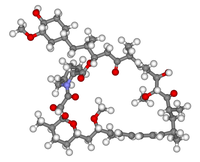
Photo from wikipedia
Background: AZD1775 is a first-in-class, potent, selective WEE1 inhibitor that has shown acceptable toxicity, linear PK, target engagement, and antitumor activity in combination with chemotherapy (phase I and II studies,… Click to show full abstract
Background: AZD1775 is a first-in-class, potent, selective WEE1 inhibitor that has shown acceptable toxicity, linear PK, target engagement, and antitumor activity in combination with chemotherapy (phase I and II studies, both Leijen S et al., J Clin Oncol 2016). In Western patients (pts), the recommended phase II dose with paclitaxel (P) and carboplatin (C) is AZD1775 225 mg bid for 2.5 days per 21-day cycle, which was used successfully in a phase II study (Oza A et al., ASCO 2015). We evaluated AZD1775 with P/C in Asian pts. Methods: In this phase Ib study (NCT02341456, D6011C00003), eligible pts had advanced solid tumors with no existing standard therapy and measurable disease by RECIST 1.1. Pts received a single oral AZD1775 dose with a 5 ± 2-day washout, then five AZD1775 doses (bid for 2.5 days per 21-day cycle) plus P (175 mg/m 2 ) and/or C (AUC 5). In a 3+3 dose-escalation design, AZD1775 was given with P/C at 175 mg (Cohort 1, n=7) or 225 mg (Cohort 2, n=6) for six cycles, or with C at 175 mg (Cohort 1a, n=6) until disease progression. Objectives were assessment of safety/tolerability (primary), PK profile, and antitumor activity (secondary). Results: 19 pts were treated; 58% were female, median age was 55 years, and 21% had breast cancer. 4/18 evaluable pts reported DLTs: two in Cohort 2 (grade 4 sepsis and grade 5 acute respiratory distress syndrome), one in Cohort 1, and one in Cohort 1a (both grade 4 platelet count decreased). Most common grade ≥3 treatment-emergent adverse events (TEAEs; all pts) were anemia, white blood cell (WBC) count decreased (both 58%), platelet count decreased (47%), neutrophil count decreased (42%), neutropenia (26%), thrombocytopenia (21%), febrile neutropenia, diarrhea, nausea, and hypophosphatemia (16% each). Most common TEAEs (all grades, all pts) were nausea (84%), vomiting, anemia (79% each), diarrhea, and WBC count decreased (68% each). For 18 pts evaluable for efficacy, ORR was 28% (table). Conclusions: As there were two DLTs in Cohort 2 (AZD1775 225 mg bid plus P/C), the safety profile at this dose was not considered tolerable. The safety profile of the combination at the lower AZD1775 dose, 175 mg bid for 2.5 days plus P/C, was considered acceptable, and this is the recommended phase II dose for Asian pts. Exposure at the 225-mg combination dose was higher in Asian than in Western pts. The safety profile was comparable in the two pt populations. Citation Format: Yung-Jue Bang, Paul De Souza, Sang-We Kim, Jason Lickliter, Yoichi Naito, Keunchil Park, Sanjeev Kumar, Ganesh M. Mugundu, Hidenori Kato. The WEE1 inhibitor AZD1775 in combination with chemotherapy in Asian patients with advanced solid tumors: a phase Ib study [abstract]. In: Proceedings of the AACR-NCI-EORTC International Conference: Molecular Targets and Cancer Therapeutics; 2017 Oct 26-30; Philadelphia, PA. Philadelphia (PA): AACR; Mol Cancer Ther 2018;17(1 Suppl):Abstract nr B183.
Journal Title: Molecular Cancer Therapeutics
Year Published: 2018
Link to full text (if available)
Share on Social Media: Sign Up to like & get
recommendations!